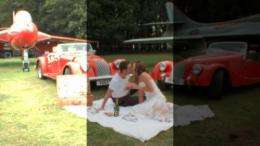Morgan car lovers first to benefit from High Dynamic Range TV's arrival on domestic TV

HDR video captures a wider range of light intensity levels found in real scenes ranging from direct sunlight to lowlight images and thanks to a partnership between Researchers at WMG, University of Warwick, goHDR Ltd. and Altera Toronto Technology Center the technology has now been developed to create an embedded system that can be connected to existing domestic televisions, allowing them to display High Dynamic Range (HDR) content.
The partners are to give the first public demonstration of HDR-enabled television working with a standard LED TV at the IBC 2011 event in Amsterdam (hall 8, stand 8.G41 from 9-13 September). Here they will show the technology using a specially created short film called 'Morgan Lovers' which was shot, manipulated, and can be displayed entirely in HDR. This was a collaborative venture with local film maker, Vermillion Films, and Morgan Cars and was brought about through WMG's International Digital Laboratory's SME programme which is funded by Advantage West Midlands.
HDR video captures a wider range of light intensity levels found in real scenes ranging from direct sunlight to lowlight images. HDR imagery offers a significantly enhanced viewing experience even when the higher contrasts are reduced (through appropriate luminance compression algorithms, known as tone mapping) for display on Low Dynamic Range (LDR) devices, such as on computer monitors or televisions. This enhanced experience allows the viewer, for example, to clearly see the details of a racing car when it enters or leaves the tunnel, or vastly reduce a passing cloud's disruption of the view of the action on a football pitch. Furthermore, the increased lighting of HDR content provides better depth perception, allowing a 3D viewing experience without the need to wear special glasses.
WMG's Professor Alan Chalmers said:
"This project has brought together worldwide expertise in HDR imaging from the University of Warwick with the innovation and in-depth market knowledge of goHDR and Altera. Together the partners have demonstrated the technical and commercial viability of HDR-enabled television."
"HDR video has very large data and computational requirements. This creates significant challenges for video processing on a low power embedded platform such as a television or set-top box. Our project comprises a highly novel system in which compressed HDR video content is carefully streamed from goHDR's compression algorithm to an Altera Field Programmable Gate Array (FPGA) which exploits massive amounts of parallelism to achieve high processing rates at a fraction of the power required by other solutions. The goHDR's compression is specifically designed for HDR video and is able to achieve at least 100:1 compression with minimal perceptual loss.
Provided by University of Warwick



















